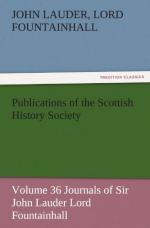[578] As to Ramsay of Balmain
being created Earl of Bothwell by James
III.,
see p. 205.
Saw nixt day Furd, Whitkirk, Craig, Hepburn, Balgone, Semple, Leuchie, Merjoribanks, Sydserfe, Achesone, Cassilton, Tomtallon, both the Marquis of Douglasses, and the Basse, 2 mile within the sea, about a short mile in circumference. Saw the May, belongs to Barnes Cunyghame. Saw Fentontour, ware Haliburtons and Wisconts, then purchased by the Earle of Gourie, now my Lord Advocats:[579] saw the Heuch-Home.
[579] Sir John Nisbet.
Nixt day went for Hadington: saw Ethelstanefield.[580] In Hadington saw my Lord Lawderdales buriall place, werie magnifiek. The Lord Yesters got Zester by mariage of the only child of my Lord Giffart. He had Beltan by marieng with a Cunyghame.
[580] Probably Athelstaneford.
In the coming to Edenbrugh saw Eister and Wester Adenstens, that is also their name; then Tranent, and neir it Windiegoule; then Elphinstone; then on the cost syde Cockenie, Seaton, Preston, Prestongrange, the Pans, Landnidrie:[581] up on the brae are Wallyfield, Dauphinton, Carberrie and Fausyde.
[581] Now Longniddry.
Master Thomas Scot of Abbotshall in King James the 5th tyme was Justice Clerk. Vide Hopes Collections, page 12, in principio.
The Lairds of Glenbervie are not the oldest Douglasses as some say, but a cadet of Angus maried the heritrix theirof, they being then Melvils verie old in that name, and the powerfullest in all the Mearnes. They ware heritable shireffs their, and on of them being a great oppressor of the wholle country, manie complaints were made of him to the King. The King once answering that he cared not tho’ they supped him in broth, they presently went and took him to a hill syde which they yet show, put on a ketle and boiled him their, and each of them took a soop out of it. It was in 1417.[582]
[582] This story is told more
fully by Sir W. Scott in a note to
Leyden’s
ballad ‘Lord Soulis,’ Border Minstrelsy,
vol. ii. p.
350,
ed. 1802. Albany was Regent in 1417.
They tell that amongs the manie Universities that are at Lovain their is one which of old was institute for poor scollars who had nought wheiron to maintaine themselfs, but that their diet was verie sober, nothing but bread and very small bread. At a tyme on of the students in it having a great stomack, in a rage sayd to his other fellows, If I ware Pope of Rome I would make the students of this Colledge to fare better then they do. He came to be Pope, and endowed that Colledge with great revenues, so that its the richest now in all Lovain.
Of all the histories we have on record of magicians and sorcerers that seimes to me most strange which is reported of Ascletarion by Suetonius,[583] in Vita Domitiani, in pagina 82.




